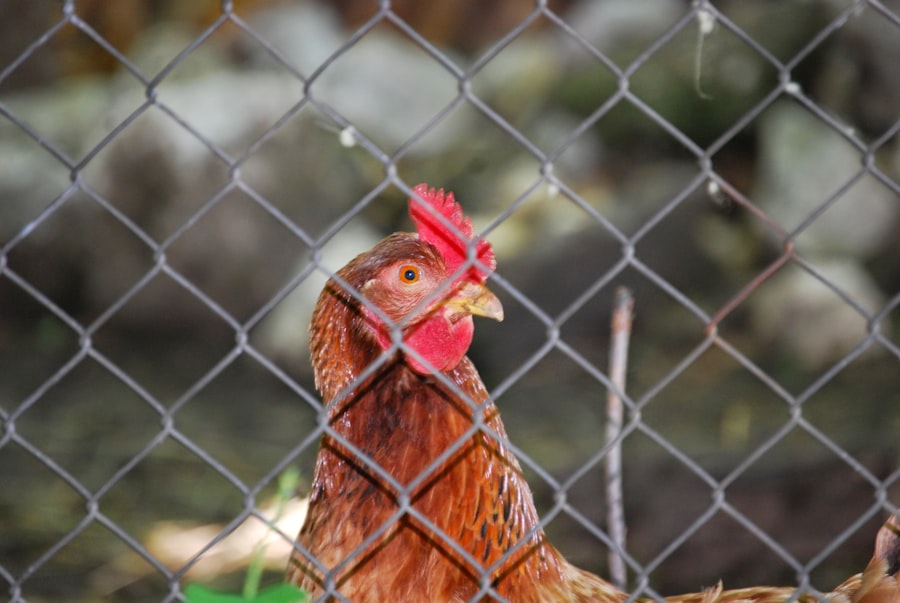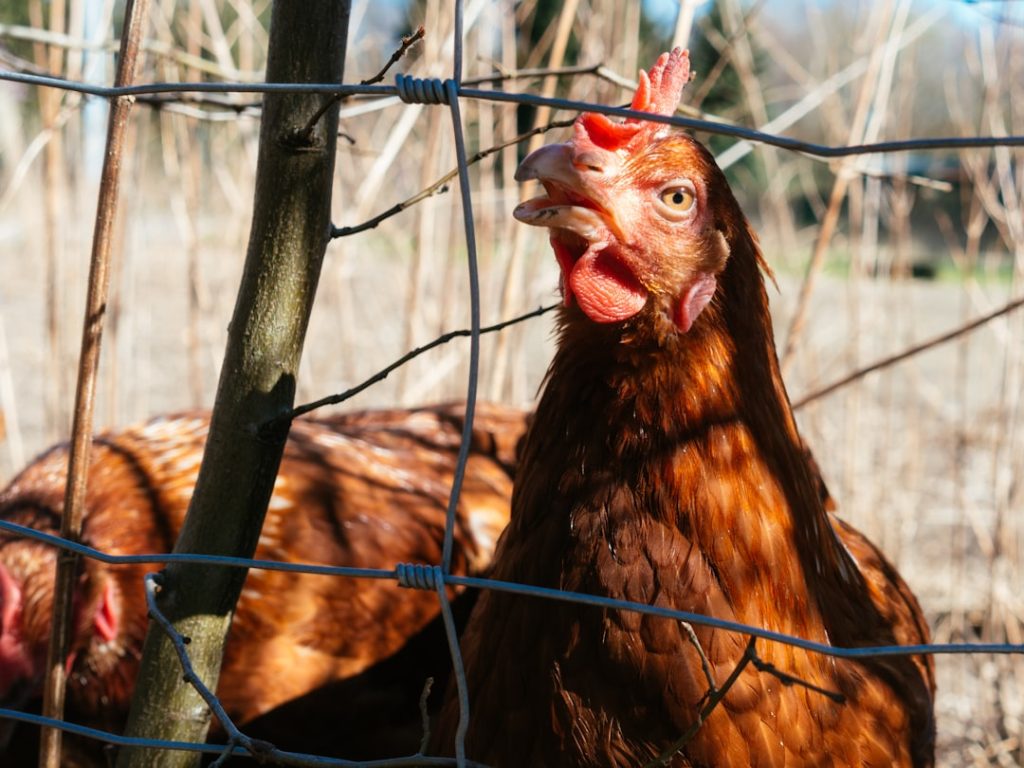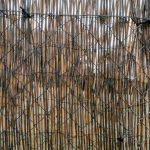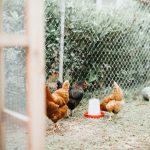Fencing is a critical element in ensuring the safety and security of chickens within their enclosure. Chickens have a natural inclination to forage and may wander if not properly contained. A well-constructed fence serves as a physical barrier, preventing chickens from straying into potentially dangerous areas where they could encounter predators, vehicles, or other hazards.
Moreover, fencing helps establish clear boundaries for the flock, providing them with a sense of security and familiarity within their designated space. This defined area can contribute to reduced stress and anxiety among the chickens, ultimately promoting better overall health and well-being. The protective function of fencing extends beyond containing the chickens; it also plays a crucial role in safeguarding them from potential predators.
Without adequate fencing, chickens are susceptible to attacks from various animals, including foxes, raccoons, and birds of prey. A secure fence acts as a deterrent to these predators and provides an essential layer of defense against potential threats. Additionally, proper fencing can help prevent interactions with neighboring pets or wildlife, thereby reducing the risk of injury to the chickens or the transmission of diseases.
In summary, fencing is an indispensable component in creating a safe, controlled environment where chickens can thrive.
Table of Contents
- 1 Types of Fencing Materials for Chicken Runs
- 2 Installing Fencing to Prevent Chickens from Flying Out
- 3 Tips for Maintaining Fencing to Ensure Chicken Safety
- 4 Alternatives to Fencing for Keeping Chickens in the Run
- 5 Addressing Common Challenges with Chicken Fencing
- 6 Creating a Safe and Secure Environment for Your Chickens
- 7 FAQs
- 7.1 What is the purpose of fencing to keep chickens from flying out of the run?
- 7.2 What type of fencing is best for keeping chickens from flying out of the run?
- 7.3 How high should the fencing be to prevent chickens from flying out of the run?
- 7.4 Are there any other measures that can be taken to prevent chickens from flying out of the run?
- 7.5 Is it important to regularly inspect and maintain the fencing to keep chickens from flying out of the run?
Key Takeaways
- Fencing is important for keeping chickens in the run to protect them from predators and to prevent them from wandering into unsafe areas.
- Common types of fencing materials for chicken runs include chicken wire, hardware cloth, and electric netting.
- Installing fencing to prevent chickens from flying out involves ensuring the fence is tall enough and using deterrents such as netting or clipping wings.
- Tips for maintaining fencing to ensure chicken safety include regular inspections for damage, securing any loose areas, and keeping vegetation trimmed.
- Alternatives to fencing for keeping chickens in the run include using chicken tractors, portable electric fencing, or creating a secure enclosed area with netting or mesh.
- Common challenges with chicken fencing include predators digging under the fence, chickens finding ways to fly over, and weather-related damage to the fencing.
- Conclusion: Creating a safe and secure environment for your chickens involves choosing the right fencing, installing it properly, and regularly maintaining and addressing any challenges that may arise.
Types of Fencing Materials for Chicken Runs
Chicken Wire: A Lightweight and Flexible Option
When it comes to selecting fencing materials for a chicken run, chicken wire is a popular choice. It is a lightweight and flexible option that provides good visibility and ventilation for the chickens. However, it may not be the most durable option and may not provide adequate protection against larger predators.
Hardware Cloth and Electric Fencing: Sturdier Options
Hardware cloth is a sturdier option that offers better protection against predators, but it may be more expensive and require more effort to install. Electric fencing is another option to consider, which can be an effective deterrent for predators and can also prevent chickens from flying out of the run. Electric fencing delivers a mild shock to any animal that comes into contact with it, effectively discouraging predators and keeping chickens contained.
Chain Link Fencing: A Durable and Long-Lasting Choice
Chain link fencing is another popular choice for chicken runs, as it provides a strong and durable barrier that can withstand the elements and potential predator attacks. While it may be more expensive than other options, chain link fencing offers long-term security and peace of mind for chicken owners.
Factors to Consider When Choosing a Fencing Material
Ultimately, the choice of fencing material will depend on factors such as budget, predator pressure, and the specific needs of the chicken flock. By considering these factors, chicken owners can make an informed decision and choose the best fencing material for their chicken run.
Installing Fencing to Prevent Chickens from Flying Out

In addition to keeping predators out, it’s important to install fencing that prevents chickens from flying out of the run. Chickens are capable of flying short distances and may attempt to escape if they feel confined or stressed. To prevent this, it’s important to install fencing that is tall enough to prevent chickens from flying over it.
Additionally, adding a cover or netting over the top of the run can further discourage escape attempts and provide an extra layer of protection against aerial predators. Another consideration when installing fencing to prevent chickens from flying out is to ensure that there are no gaps or weak points in the fence where chickens could squeeze through or find a way to escape. Regularly inspecting the fencing for any damage or wear and tear can help to identify and address potential escape routes before they become a problem.
Additionally, trimming any overhanging branches or vegetation near the fence line can help to prevent chickens from using them as launch pads for escape attempts. It’s also important to consider the layout and design of the chicken run when installing fencing to prevent flying out. Providing plenty of enrichment and space within the run can help to reduce the likelihood of chickens attempting to escape out of boredom or frustration.
Creating a secure and stimulating environment within the run can help to keep the chickens content and less inclined to seek out ways to fly over the fence.
Tips for Maintaining Fencing to Ensure Chicken Safety
Proper maintenance of the fencing is essential for ensuring the safety and security of the chickens in the run. Regular inspections should be conducted to check for any damage or wear and tear that could compromise the integrity of the fence. This includes looking for rust, corrosion, loose wires, or any other signs of deterioration that could weaken the fence and make it vulnerable to predator attacks or escape attempts by the chickens.
In addition to visual inspections, it’s important to regularly test any electric fencing to ensure that it is functioning properly. This may involve checking the voltage levels and testing the fence with a grounding rod to verify that it is delivering an effective shock. Any issues with the electric fencing should be promptly addressed to maintain its effectiveness as a predator deterrent and containment barrier for the chickens.
Another important aspect of maintaining fencing for chicken runs is keeping the surrounding area clear of debris and vegetation that could compromise the integrity of the fence. Overgrown vegetation can provide cover for predators and potential escape routes for the chickens, so regular trimming and clearing of the area around the fence can help to maintain its effectiveness. Finally, proactive measures such as reinforcing weak spots, repairing any damage promptly, and investing in high-quality materials can all contribute to ensuring that the fencing remains secure and reliable for the long-term safety of the chickens.
Alternatives to Fencing for Keeping Chickens in the Run
While fencing is a popular and effective option for keeping chickens contained in their run, there are alternative methods that can also be considered. One option is using poultry netting or mesh panels to create a physical barrier around the perimeter of the run. This can provide similar benefits to traditional fencing while offering more flexibility in terms of installation and configuration.
Another alternative to traditional fencing is using natural barriers such as hedges or shrubs to create a boundary around the chicken run. This can provide a more aesthetically pleasing option while still offering some level of protection against predators and containment for the chickens. However, natural barriers may require more maintenance and upkeep compared to traditional fencing options.
Additionally, creating a secure outdoor enclosure or “chicken tractor” that can be moved around the yard can provide a safe and controlled environment for chickens without the need for permanent fencing. This option allows chickens to have access to fresh grass and insects while still being contained within a secure enclosure. Ultimately, the choice of alternative methods for keeping chickens in the run will depend on factors such as available space, budget, predator pressure, and personal preferences.
Addressing Common Challenges with Chicken Fencing

Predator-Proofing Your Flock
While fencing is an effective tool for keeping chickens safe and contained in their run, one common challenge is dealing with persistent predators that may attempt to breach or circumvent the fence in order to access the chickens. In these cases, additional measures such as predator-proofing the coop, using deterrents such as motion-activated lights or sound devices, or even employing guard animals such as dogs can help to reinforce the security of the chicken run.
Managing Escape Artists
Another challenge with chicken fencing is managing potential escape artists within the flock. Some breeds of chickens are more prone to flying over fences or finding creative ways to escape from their enclosure. In these cases, providing enrichment within the run, such as perches, dust baths, and toys, can help to keep the chickens occupied and less inclined to attempt escape. Additionally, trimming wings or using deterrents such as netting or covers over the top of the run can help to prevent escape attempts.
Weather-related challenges can also impact the effectiveness of chicken fencing. Harsh weather conditions such as strong winds, heavy snowfall, or flooding can damage fencing and compromise its ability to contain and protect the chickens. Regular maintenance and proactive measures such as reinforcing weak spots or providing additional support during extreme weather events can help to mitigate these challenges.
Creating a Safe and Secure Environment for Your Chickens
In conclusion, fencing plays a crucial role in creating a safe and secure environment for chickens in their run. It provides protection against predators, establishes boundaries for the flock, and helps to prevent escape attempts by the chickens. When choosing fencing materials for a chicken run, factors such as durability, predator pressure, and budget should be taken into consideration.
Proper installation and maintenance of the fencing are essential for ensuring its effectiveness in containing and protecting the chickens. While traditional fencing is a popular option, alternative methods such as poultry netting, natural barriers, or movable enclosures can also be considered based on individual needs and preferences. Addressing common challenges with chicken fencing, such as predator pressure, escape attempts, and weather-related issues, requires proactive measures and careful management.
By prioritizing the safety and security of their flock through proper fencing and containment measures, chicken owners can create an environment where their chickens can thrive and flourish without unnecessary risks or threats. Ultimately, investing in high-quality fencing and implementing proactive maintenance practices will contribute to creating a safe and enjoyable space for both chickens and their owners alike.
If you’re looking for ways to keep your chickens from flying out of their run, you might want to check out this article on poultrywizard.com. They offer tips and ideas for creating a large chicken coop that will keep your chickens safe and secure.
FAQs
What is the purpose of fencing to keep chickens from flying out of the run?
Fencing is used to create a barrier around the chicken run to prevent chickens from flying out and wandering into areas where they may be at risk from predators or traffic.
What type of fencing is best for keeping chickens from flying out of the run?
The best type of fencing for keeping chickens from flying out of the run is typically a high-quality poultry netting or wire mesh that is at least 6 feet tall. This will prevent the chickens from being able to fly over the top.
How high should the fencing be to prevent chickens from flying out of the run?
The fencing should be at least 6 feet tall to prevent chickens from being able to fly over the top. This height is generally sufficient to keep most chicken breeds from escaping.
Are there any other measures that can be taken to prevent chickens from flying out of the run?
In addition to using tall fencing, trimming the feathers on one wing of each chicken can also help to prevent them from being able to fly over the fencing. This is a common practice for keeping chickens contained within a run.
Is it important to regularly inspect and maintain the fencing to keep chickens from flying out of the run?
Yes, it is important to regularly inspect and maintain the fencing to ensure that there are no holes or weak spots that could allow chickens to escape. Regular maintenance will help to keep the chickens safely contained within the run.
Meet Walter, the feathered-friend fanatic of Florida! Nestled in the sunshine state, Walter struts through life with his feathered companions, clucking his way to happiness. With a coop that’s fancier than a five-star hotel, he’s the Don Juan of the chicken world. When he’s not teaching his hens to do the cha-cha, you’ll find him in a heated debate with his prized rooster, Sir Clucks-a-Lot. Walter’s poultry passion is no yolk; he’s the sunny-side-up guy you never knew you needed in your flock of friends!







